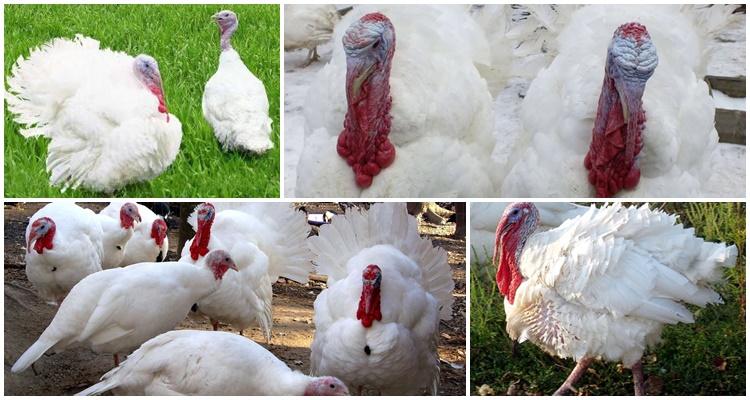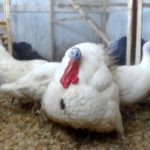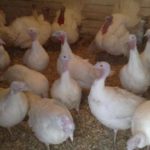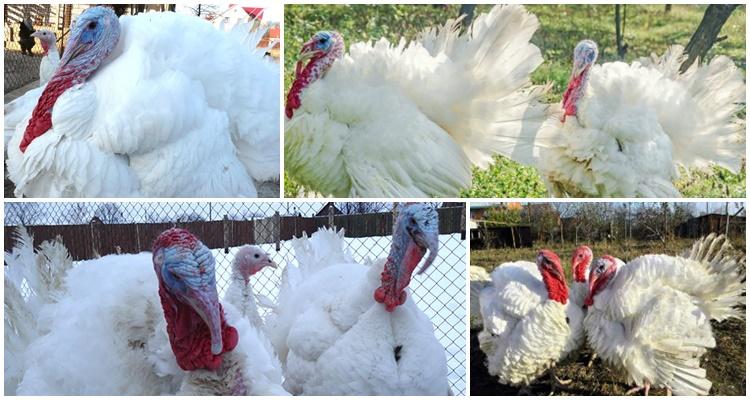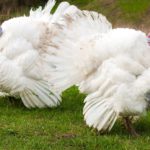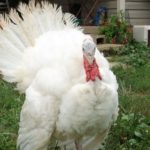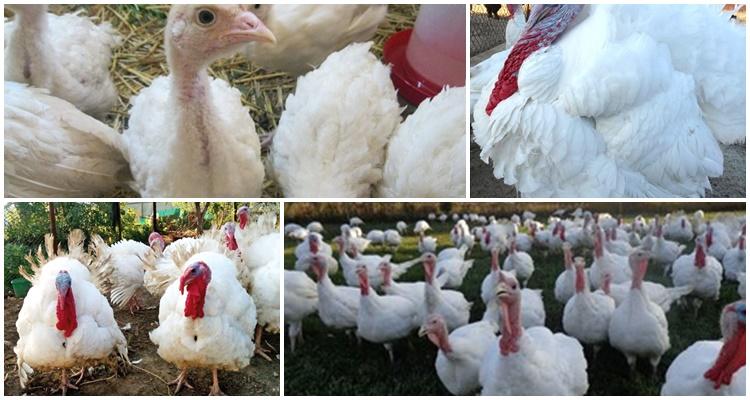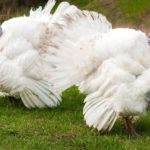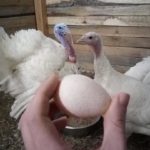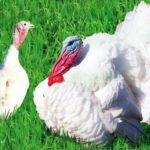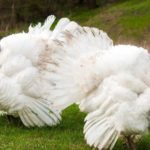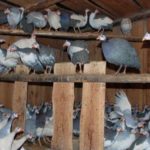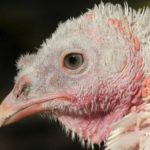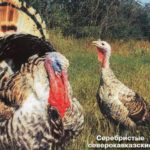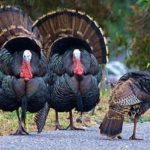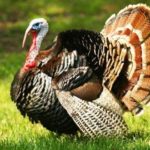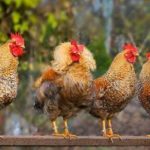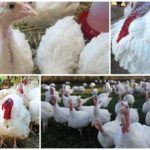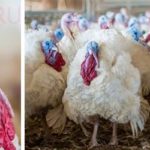Raising turkeys at home It is recommended to start by choosing universal breeds for breeding. This group of breeds includes white broad-breasted turkeys, characterized by rapid weight gain, tasty high-quality meat and the ability to adapt to living conditions. Turkeys are highly productive and have good disease resistance.
History of creation
The breed was created by crossing a bronze broad-breasted bird and a white Dutch bird.Crossing work was carried out by American specialists for 10 years. The resulting breed showed the effect of heterosis. Heterosis is the quality of the resulting line exceeding all the characteristics of the parent line in terms of performance, productivity, and resistance to infections.
The breed of white broad-breasted turkeys became the basis for further crossbreeding. From them such productive breeds as Stavropol Victoria, Grade Mator and others were obtained.
Description and characteristics of the breed
Broad-breasted white turkeys can be distinguished by their snow-white plumage, which has a glossy sheen. A characteristic feature of the breed is the presence of a black medallion-shaped spot on the central upper part of the sternum.
Breed characteristics:
- dense plumage in the tail area;
- muscular, wide, developed chest;
- body in the shape of a semi-oval;
- the presence of growths on the neck and head;
- the upper body is partially exposed.
Turkeys look smaller than males. The maximum weight of a female is 11 kilograms, the weight of a turkey reaches 25 kilograms.
Table of weight indicators by age.
| Age | Maximum indicator |
| 2 months | 2-3 kilograms |
| 1 year | 5-7 kilograms |
| more than 1 year | from 7-9 kilograms |
Turkey poults gain a kilogram of pure meat mass in a few days. This breed is distinguished by the fact that young animals can easily be brought to the required body weight if high-calorie foods are included in the diet. The optimal option for slaughter is when the individual reaches 2 months of age. By this time, the turkey weighs 2 kilograms or more. 6 months is the most profitable slaughter period when keeping poultry for meat production.
Sexual maturity of the breed occurs at 8-9 months, which means that from this age turkeys are ready to lay eggs.Egg production is characterized as productive, average in terms of indicators. The female brings up to 120 eggs annually. The average weight of an egg is 80 grams. The dense shell allows for up to 75 percent of chicks to hatch. Survival rates reach 90 percent.
Pros and cons of white broad-chested
Turkeys belong to the category of universal breeds, they have advantages and disadvantages.
The disadvantages of the breed are the possible heterogeneity that occurs when domestically crossing turkeys of different types.
Reference! Turkeys of this breed fly well, so breeders are advised to build high fences in order to preserve and protect the livestock.
Breed subspecies
There are several subspecies within the breed, which are distinguished by weight:
- Lungs. These are turkeys, whose body weight varies from 5 to 9 kilograms. They adapt well to different living conditions and gain weight on any type of diet.
- Average. Turkeys of this subspecies grow up to 17 kilograms, turkeys - up to 9 kilograms.
- Heavy. The largest turkeys can weigh 25 kilograms by the age of 2 years. Owners achieve this weight by purposefully fattening the birds.
Reference! The breed of white broad-breasted turkeys constitutes a group of birds of the meat and dairy line. This means that birds are raised for their eggs and meat.
Features of maintenance and care
Raising turkeys at home “from scratch” begins with the arrangement of the territory intended for placement.
The turkey house must be equipped in accordance with the requirements:
- Arrangement of perches. Perches are placed at a height of at least 70 centimeters. Each bird is provided with up to 40 centimeters of free space.
- Arrangement of nests. One nest is made for 5 birds. A turkey nest is a structure with an accessible entrance and sides that limit the interior space.
- Arrangement of feeders and drinkers. Be sure to place structures with a backing. The substrate protects against loss of feed. Drinkers are placed at a height of 80 centimeters to prevent birds from splashing water.
In order for turkeys to fully develop, the turkey house is provided with lighting, temperature is maintained, and ventilation is provided. In winter, artificial light is turned on for birds so that daylight hours last 12-13 hours. To allow more light into the turkey house, you need to cut a window next to the door. One window is enough for 1 square meter of space.
Domestic turkeys do not tolerate drafts well, so before the weather gets cold, the cracks in the turkey poultry are caulked, the doors are insulated, and various types of openings are sealed.
The optimal air temperature at which a turkey is comfortable is a temperature from +18 to +25 degrees. When the temperature drops, it is necessary to insulate the room; when the air temperature rises, additional sources of drinking should be provided.
In summer, the bird needs a walk. Pens are specially built for turkeysso that they can calmly walk around the territory without leaving the visibility zone.
Information! It is recommended to use durable wood to make perches, since turkeys weigh a lot.Under their weight, fragile perches can break.
What to feed the birds
Raising turkeys involves providing the birds with a complete, balanced diet.
Feeding Features:
- adults are fed 3 times daily, but during the mating period the frequency of feedings is increased to 5;
- In summer, juicy, fresh grass is added to the menu;
- In winter, the diet is supplemented with grated vegetables (beets, carrots);
- in addition to food, birds should have free access to drinking bowls.
The diet of turkeys consists of the following items:
- various factory-produced combined feeds;
- cereals such as corn, barley, oats;
- boiled peas;
- wheat bran;
- sunflower meal;
- mineral additives such as yeast, chalk, meat and bone meal, salt, gravel or shells;
- vitamin supplements.
Reference! Juicy feed affects the dryness/juiciness of meat. The more juicy feed, the juicier the resulting meat.
Subtleties of breeding
Turkeys of this breed are good hens. One female hatches up to 20 chicks. A turkey is capable of hatching planted chicken or duck eggs without applying the principle of selection. The incubation process lasts from 28 to 32 days. In addition to the natural method, when breeding at home, they use the method of incubating eggs. It is 90 percent effective.
When turkey chicks appear, it is necessary to adhere to certain rules that will help raise healthy offspring:
- in the first days, turkey poults are fed with cereal mixed with boiled eggs;
- after some time, the chicks begin to be fed food high in fiber, this is due to the fact that the intestines of the young are structured like a long curved loop, which requires additional help to empty;
- Do not give chicks dirty or low-quality food; due to its structure, the food remains in the stomach for a long time and can cause an infection;
- during the first 10 days, the chicks are fed 8 to 10 times daily, they need plenty of fluids and an additional source of vitamin C, which helps build immunity;
- on the 4-5th day of life, the chicks are given cottage cheese, it compensates for the turkey poults’ lack of minerals and vitamins;
- for chicks, feeders are equipped in such a way that the birds cannot fall into them, since they die if they get too wet;
- During the first 10 days of life, turkey poults are artificially illuminated with specially installed lamps.
Information! On the first day after hatching, the chicks are not fed, but given water.
Diseases and prevention
The main danger for a turkey breeder is the development of a disease in one pet or the spread of an epidemic in the entire livestock.
Turkeys are susceptible to the following diseases:
- Hard goiter. This condition develops due to the fact that the bird begins to greedily grab food. This phenomenon is observed after a forced or spontaneous hunger strike, when an individual has not received food for a long time. The development of goiter is caused by swelling of grains in one part of the pharynx. The process can be determined by the hardening of the goiter, refusal of food or drink. A blocked goiter is treated surgically. The goiter is opened and cleaned.
- Tuberculosis. A dangerous disease that threatens the loss of birds. The tuberculosis bacillus is hidden in dirty dishes intended for feeding, in parts of food that remain on the floor of the turkey poultry, in bedding that has not been treated after infected birds. When infected, a bird begins to move slowly, loses appetite, and a small rash appears on the skin.A sick bird cannot be cured. As soon as possible, it is necessary to isolate the turkey, treat and ventilate the premises.
- Helminthiasis. Worms often bother turkeys. They spread through feces, soil, and contaminated litter. Worms often appear in chicks. Parasites can be detected by the behavior of turkeys. They squeak, behave restlessly, begin to eat food uncontrollably, and many of them develop diarrhea. To get rid of worms, anthelmintics and special removal techniques are used.
- Smallpox. This is a dangerous disease that affects turkeys. The virus enters the poultry house from the outside throughout all seasons. It is spread by pets, as well as rodents and large insects. Smallpox is manifested by inflammation of the mucous membranes, prolapse of the eye sockets, and the appearance and spread of a rash. Smallpox can be prevented by mandatory vaccination.
Preventive support measures:
- ensuring good living conditions;
- maintaining air temperature and humidity;
- timely vaccination;
- regular inspection of livestock;
- drawing up a balanced diet with the addition of essential vitamins and minerals.
Breeders claim that breeding white broad-breasted turkeys pays off in an average of 5 months.

